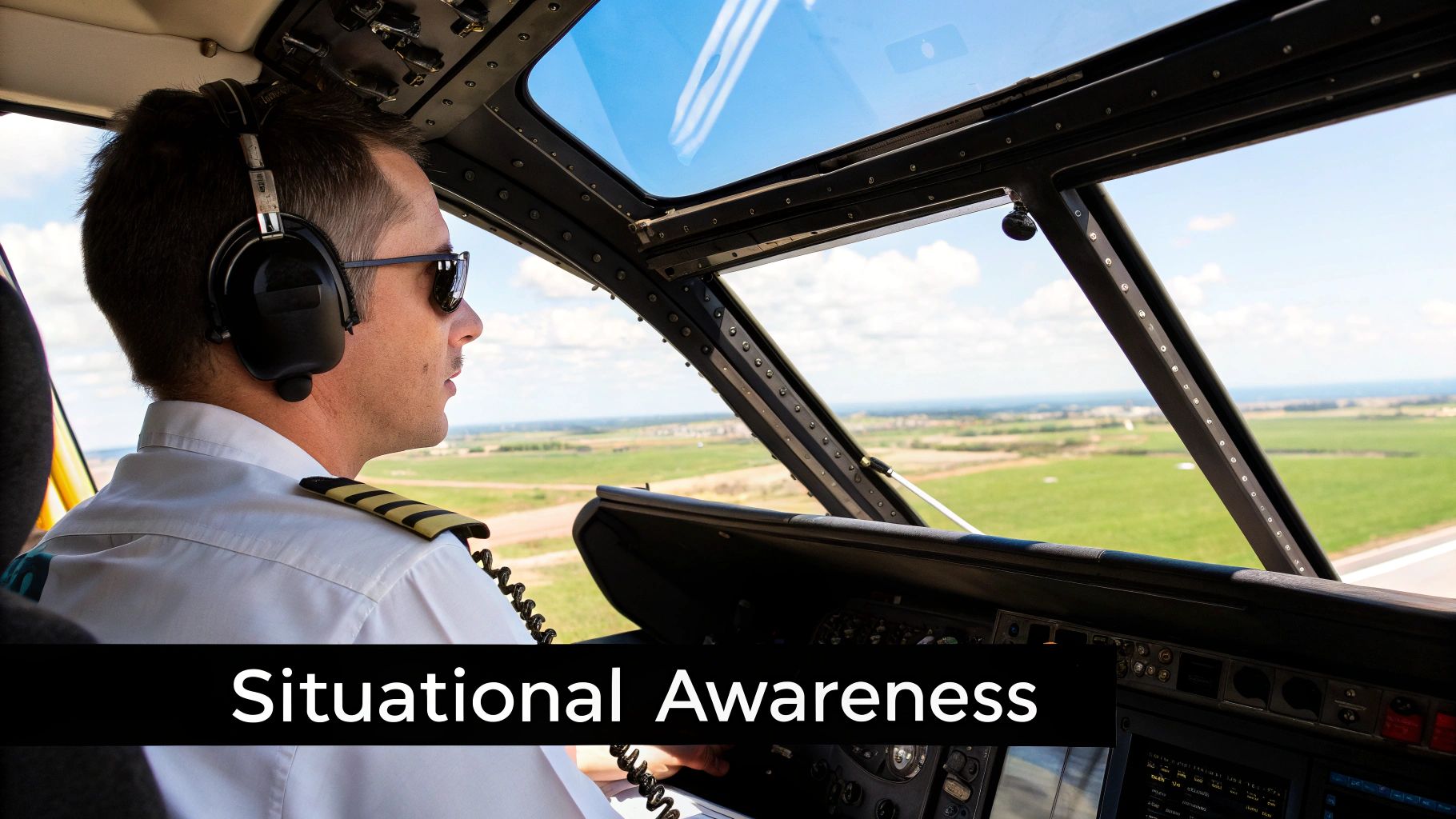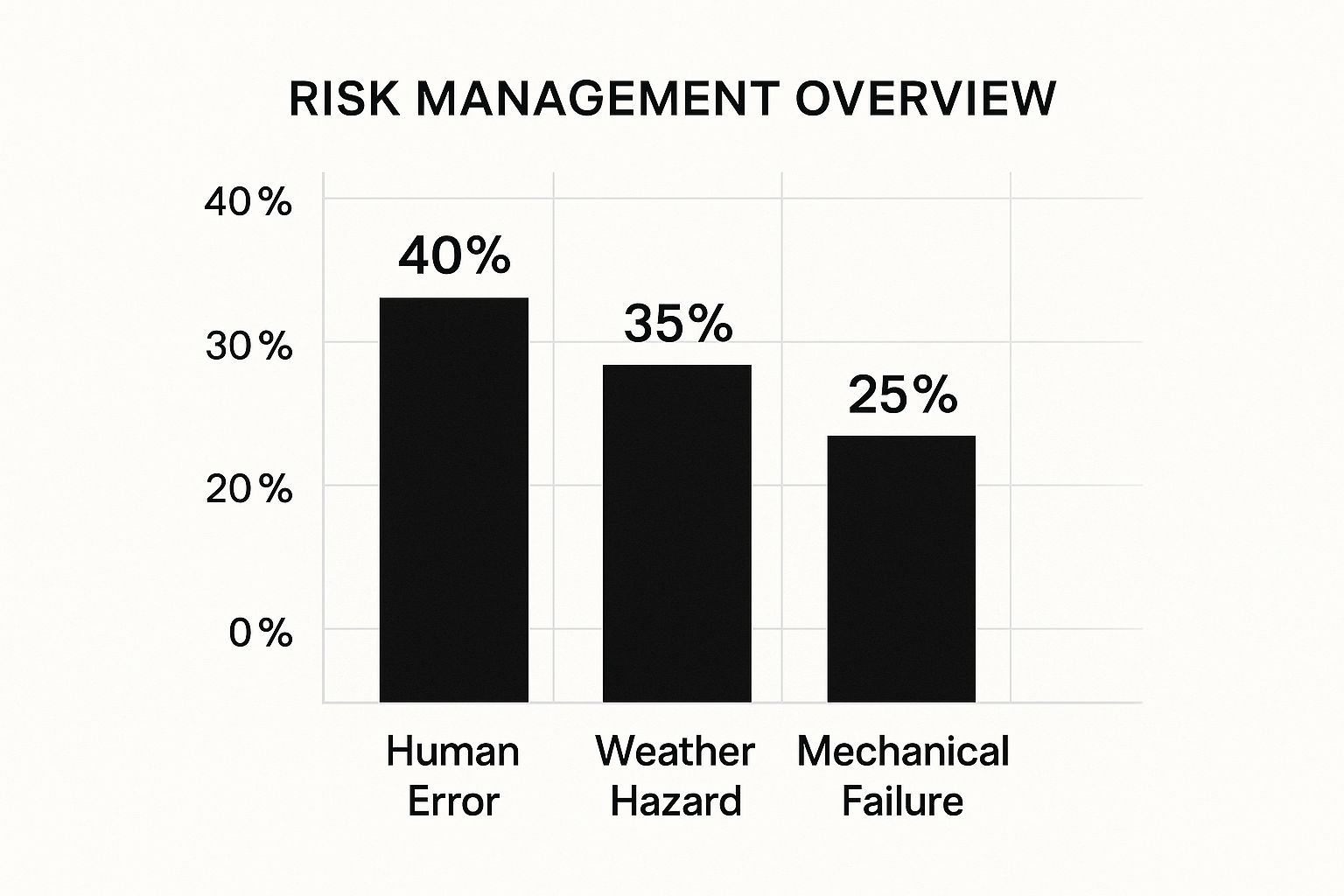Aeronautical decision making (ADM) is more than just checklists and procedures. It’s the foundation of aviation safety, encompassing the ability to assess risks, make sound judgments, and adapt to unexpected situations. This goes beyond simply knowing how to operate an aircraft.
The Real-World Impact of Aeronautical Decision Making
Imagine encountering unexpected weather mid-flight. Your technical skills help control the aircraft, but ADM guides the decision to divert, hold, or continue, based on a realistic evaluation of the situation. This highlights ADM’s vital role in ensuring a safe outcome.
Why Aeronautical Decision Making Matters
Poor decisions in the cockpit have consequences, ranging from minor inconveniences to catastrophic accidents. Aviation’s high-stakes environment makes effective decision-making paramount. Unlike driving, a pilot can’t simply pull over.
Quick thinking under pressure is essential. The complexity of flight operations, including weather, air traffic, and aircraft systems, further emphasizes the importance of sound judgment.
One study powerfully illustrates this point. An analysis of 29 years of aviation accident data, involving U.S. private pilots flying single-engine airplanes, showed flawed ADM contributed to over 50% of fatal crashes in this category. These errors often involved poor risk assessment, inadequate preflight planning, and failure to adapt. More details can be found here: Breakdowns in Decision Making
From Accidents to Frameworks
The field of ADM has evolved considerably, learning from past accidents. Early investigations often cited pilot error, but it became clear these errors stemmed from flawed decision-making processes.
This led to structured frameworks like the DECIDE model and the OODA loop. These provide pilots with systematic approaches for assessing situations and making informed decisions under pressure.
The DECIDE model, for instance, prompts pilots to Detect a problem, Estimate its severity, Choose a course of action, Identify necessary steps, Do those steps, and Evaluate the outcome. This structured approach significantly improves safety.
Beyond Judgment: A Learned Skill
“Pilot judgment” was once considered an inherent trait. Modern aviation recognizes ADM as a learnable, practicable, and improvable skill. Like mastering flight maneuvers, developing strong ADM takes training and repetition.
This involves understanding influencing factors, like stress, fatigue, and biases, and developing mitigation strategies to make the best choices, even under pressure. This focus on training and continuous improvement is crucial for all pilots, from students to seasoned professionals.
Building Your Aeronautical Decision Making Toolkit

Effective aeronautical decision making (ADM) involves more than just recalling the DECIDE model. It requires cultivating a personalized set of practical strategies you can employ under pressure. This translates to developing dependable decision-making frameworks, even when facing difficult circumstances.
Essential Tools For Sound Judgment
Professional aviators use a mix of mental checklists and systematic risk assessment methods to enhance their ADM. For example, a quick mental run-through of the IMSAFE checklist (Illness, Medication, Stress, Alcohol, Fatigue, Emotion) before each flight can reveal potential personal limitations.
Understanding the bigger picture of aeronautical data is also crucial. You can explore more about aeronautical information management for a more complete understanding of this vital subject.
- Situational Awareness: Constantly evaluating your surroundings, aircraft status, and weather conditions is the foundation of sound decisions.
- Risk Management: Spotting and mitigating potential hazards, from shifting weather patterns to mechanical malfunctions, is critical. This includes using tools like the PAVE checklist (Pilot, Aircraft, enVironment, External pressures).
- Stress Management: Recognizing and managing your reactions to stress is essential, as stress can severely impair judgment and contribute to poor choices.
Practical Frameworks for In-Flight Decisions
These elements combine to form strong decision-making processes. Think of situational awareness as the foundation, risk management as the structure, and stress management as the roof that protects the entire process.
Several frameworks can provide structure for in-flight decisions:
- Aviate, Navigate, Communicate: This prioritizes the most important tasks in any emergency, ensuring aircraft control is maintained before dealing with other issues.
- The 3Ps (Perceive, Process, Perform): This method simplifies complex situations into manageable steps, from problem identification to action.
- The DECIDE Model: This offers a thorough, step-by-step method for assessing situations and forming educated conclusions.
To help illustrate the differences between these and other ADM models, let’s take a look at a comparison table.
ADM Models Comparison
This table compares different aeronautical decision making models and frameworks used in aviation training.
| ADM Model | Key Components | Best Application Scenarios | Limitations |
|---|---|---|---|
| Aviate, Navigate, Communicate | Prioritizing aircraft control, navigation, and communication | Emergency situations | Oversimplification for complex problems |
| 3Ps (Perceive, Process, Perform) | Simplifying problem-solving into manageable phases | Time-critical decisions | Requires thorough understanding of procedures |
| DECIDE Model | Structured, step-by-step decision-making process | Various in-flight scenarios | Can be time-consuming in emergencies |
| PAVE Checklist | Assessing pilot, aircraft, environment, and external pressures | Pre-flight planning and risk assessment | Doesn’t provide specific solutions |
| IMSAFE Checklist | Evaluating personal factors affecting pilot performance | Pre-flight self-assessment | Relies on pilot honesty and self-awareness |
As we can see from this comparison, each model offers a different approach to ADM, each with its own strengths and weaknesses. Choosing the right model depends on the specific situation and the pilot’s individual needs.
Recognizing Personal Limitations
Even with the best tools, pilots are human. Recognizing personal limitations and biases is key to preventing errors. Fatigue, for example, can drastically reduce the capacity for good judgment. Studies indicate that after 17 hours without sleep, performance can be comparable to having a 0.05% blood alcohol content.
This means acknowledging limitations and creating strategies to mitigate them, such as sufficient rest and delegating tasks when appropriate, is vital. Building an ADM toolkit is an ongoing endeavor, one that improves skills and increases safety margins with each flight.
Critical Decision Moments Every Pilot Will Face

The infographic above provides a general overview of risk management in aviation. It breaks down the risks into three main categories: human error, weather hazards, and mechanical failure. Notice that human error accounts for the largest portion, at 40%. This highlights the significant impact aeronautical decision making (ADM) has on flight safety.
Weather and mechanical issues are also significant factors, of course. However, effective ADM helps pilots mitigate these risks as well. Every flight, from preflight checks to touchdown, presents crucial moments where a pilot’s judgment directly impacts the outcome. These are the decision points where seemingly small choices can have big consequences.
Preflight Preparation: The Foundation of Safe Decisions
Effective ADM begins long before the engine starts. Thorough preflight planning is crucial. This includes checking weather forecasts, understanding airspace restrictions, and honestly assessing your personal fitness to fly.
Having a well-defined Plan B is also essential. Consider reading about how to plan for alternate airports. This preflight preparation lets you anticipate potential challenges and develop contingency plans, significantly reducing the risk of in-flight surprises.
Takeoff and Initial Climb: Managing the High-Workload Phase
Takeoff and initial climb, while relatively short, are high-workload periods. They demand quick, accurate decision-making. Pilots must manage engine performance, monitor instruments, and maintain situational awareness, all while navigating the often complex airspace around the departure airport.
A missed approach decision in this phase, for example, requires immediate, decisive action to avoid potential hazards.
Cruise Phase: Maintaining Vigilance Despite Lower Workload
The cruise phase usually involves a lower workload. However, it’s still important to remain vigilant. Unexpected weather, system malfunctions, or air traffic control instructions can require quick adjustments to the flight plan.
Imagine encountering unexpected turbulence. This might require a change in altitude or course. This phase is where continuation bias, the tendency to stick to the original plan even when evidence suggests a change is needed, can be particularly dangerous.
Approach and Landing: The Final Hurdle
Approach and landing is another period of high workload and increased risk. Precise aircraft control, accurate navigation, and clear communication with air traffic control are essential.
This phase often involves changing weather conditions and increased traffic, adding complexity to the decision-making process. Statistical analysis shows a disproportionate number of accidents occur during specific flight phases. You can find detailed statistics from the FAA here.
To understand this further, let’s look at some data: despite cruise making up 83% of flight time, the majority of accidents occur during takeoff/initial climb (23.4%) and approach (24.1%). This highlights the critical role of sound ADM in these phases.
Accident Statistics by Flight Phase
This table presents the distribution of aviation accidents across different flight phases, highlighting where ADM failures most frequently occur.
| Flight Phase | Percentage of Flight Time | Percentage of Accidents | Key Decision Challenges |
|---|---|---|---|
| Takeoff/Initial Climb | ~10% | 23.4% | Engine management, situational awareness, missed approach decisions |
| Cruise | ~83% | Low | Weather changes, system malfunctions, maintaining vigilance, continuation bias |
| Approach/Landing | ~7% | 24.1% | Aircraft control, communication, changing weather, traffic density |
This table clearly demonstrates the increased risk during takeoff/initial climb and approach/landing. While cruise takes up a majority of the flight, the higher concentration of accidents in other phases underscores the importance of focused ADM during these critical periods.
Post-Flight Analysis: Learning From Every Experience
Even after landing, the decision-making process doesn’t end. A post-flight debrief, reflecting on choices made and areas for improvement, offers valuable insights.
This continuous learning helps refine ADM skills and prepares you for future flights. This self-reflection is crucial to becoming a safer, more proficient pilot.
Training Your Brain for Better Aeronautical Decisions

Developing sound aeronautical decision making (ADM) isn’t about innate ability. It’s about regular, focused training. Just as pilots refine their stick-and-rudder skills, they must also cultivate their judgment. This involves actively engaging in activities that challenge assumptions and strengthen decision-making processes, resulting in safer, more confident pilots.
Evidence-Based Methods for Improving ADM
Modern flight training incorporates proven methods to enhance ADM. Simulator scenarios, for example, offer a safe environment to experience challenging situations like unexpected weather or system failures. This allows pilots to test their reactions and refine their decisions under pressure.
Structured debriefings after each flight, simulated or real, are also crucial. These sessions allow for a thorough analysis of decisions, highlighting successes and pinpointing areas for improvement. This reflective process accelerates learning and reinforces best practices. Decision Intelligence AI is increasingly used for support. Learn more about this at Decision Intelligence AI.
Furthermore, leading flight schools utilize diverse training methods. Case studies of past accidents offer invaluable lessons. Scenario-based training places pilots in realistic situations demanding prompt decisions. Some schools even incorporate virtual reality for immersive training, reinforcing ADM principles and cultivating a stronger safety mindset. Aeronautical Decision Making has been shown to dramatically improve flight safety. According to the Federal Aviation Administration (FAA), operators flying around 400,000 hours annually saw a 54% reduction in accidents after implementing structured ADM training.
Customizing Your ADM Training
The best ADM training is tailored to individual needs. Student pilots benefit from focusing on fundamental decision-making frameworks and building a solid base in risk management. Experienced pilots, however, can refine their skills by targeting specific weaknesses and practicing advanced scenarios. This personalized approach maximizes training impact.
Practical Exercises for Immediate Improvement
Regardless of experience, certain exercises can immediately sharpen ADM. Regularly reviewing the IMSAFE checklist (Illness, Medication, Stress, Alcohol, Fatigue, and Emotion) before each flight is a simple yet powerful technique.
- Preflight Planning: Create detailed plans, including alternate routes and fuel reserves.
- Simulated Emergencies: Practice reacting to various in-flight challenges using a simulator.
- Post-Flight Debriefings: Critically analyze decisions and identify potential improvements.
- Mental Rehearsals: Visualize different scenarios and mentally practice the decision-making process.
By actively engaging in these practices, pilots transform decision-making from a reactive process to a proactive skillset. This consistent effort significantly enhances safety and fosters more confident and proficient aviation operations.
Tech Tools That Enhance Aeronautical Decision Making
Modern aviation leans heavily on technology. From advanced avionics to sophisticated weather information systems, pilots have access to a wealth of data that can significantly enhance aeronautical decision making (ADM). However, these tools are only as good as the pilot using them. Understanding their limitations and integrating them into a solid ADM framework is key – these tools should enhance, not replace, good judgment.
Cockpit Automation: A Balancing Act
Cockpit automation, including tools like autopilots and Flight Management Systems, can free up pilots to focus on more strategic decision-making. This is particularly valuable during demanding phases of flight. For example, an autopilot can precisely maintain altitude and heading, allowing the pilot to concentrate on navigating complex airspace or interpreting weather information.
However, over-reliance on automation can lead to complacency and a decline in essential flying skills. This can create a dangerous situation if manual control is suddenly required due to an unexpected event. Maintaining a balance between leveraging automation and staying proficient in manual flying is crucial.
Electronic Flight Bags: Managing Information
Electronic flight bags (EFBs) offer a digital alternative to paper charts and manuals. They provide instant access to crucial information, including weather forecasts, airport diagrams, and performance data. This readily available information streamlines preflight planning and boosts situational awareness during flight.
However, the sheer volume of data available on EFBs can be overwhelming. Pilots must develop strategies for filtering and prioritizing information to avoid information overload, which can hinder effective decision-making.
Weather Information Systems: Proactive Planning
Modern weather information systems, like NEXRAD radar and lightning detection networks, provide real-time weather updates. This allows pilots to anticipate hazardous weather and make informed decisions, like altering course or delaying departure. Tools like graphical weather displays make it even easier to visualize weather’s impact on the flight path by overlaying data directly onto navigation charts.
You might be interested in: Flight Simulators: How Technology Is Training Today’s Pilots.
AI-Assisted Decision Support: The Future of ADM?
The future of aeronautical decision making may involve AI-assisted decision support systems. These systems analyze vast quantities of data, identify potential hazards, and suggest courses of action. For instance, an AI system could integrate real-time weather data, aircraft performance, and air traffic to recommend the optimal flight path for minimizing fuel consumption or avoiding turbulence.
While promising, it’s essential to remember that these systems are tools designed to support, not replace, human judgment. The pilot remains ultimately responsible for all decisions.
The Importance of Sound Judgment
Technology offers powerful tools, but sound aeronautical judgment remains paramount. Pilots must understand the limitations of technology, maintain proficiency in basic flying skills, and consistently apply sound ADM principles. By integrating these tools thoughtfully into a comprehensive decision-making framework, pilots can enhance their abilities and contribute to safer, more efficient flights.
The Human Factor: When Your Brain Works Against You
Even seasoned pilots grapple with inherent human limitations. These biological and psychological factors can significantly affect judgment and, as a result, aeronautical decision making (ADM). Let’s explore how fatigue, stress, emotions, and cognitive biases can impact your performance in the cockpit.
The Impact of Fatigue
Fatigue is a serious adversary to sound judgment. It diminishes attention, slows reaction time, and impairs cognitive function. Imagine wrestling with a complex problem after 24 hours without sleep. Your thinking becomes fuzzy, and your decision-making abilities suffer. This is the very challenge pilots face when combating fatigue.
Studies show that even moderate sleep deprivation can measurably impact performance. After 17 hours without sleep, performance can be comparable to having a 0.05% blood alcohol content. This underscores the importance of prioritizing rest and recognizing fatigue’s signs before safety is compromised.
Stress and Decision-Making
Stress also heavily influences our decisions. Under pressure, our thinking narrows, and we may revert to ingrained habits, potentially overlooking vital details. For instance, a pilot stressed by inclement weather might focus solely on reaching their destination, possibly ignoring warnings suggesting a diversion.
This is where effective stress management techniques become essential. By learning to identify stress symptoms, both physical and mental, pilots can use coping mechanisms to maintain clarity under duress.
Emotional Influences
Emotions, though often overlooked, can significantly sway decisions. A pilot frustrated by a mechanical issue might make rash choices that worsen the problem. Similarly, anxiety or fear can cloud judgment, leading to errors in risk assessment.
Maintaining emotional awareness is as vital as monitoring engine instruments. Recognizing and managing emotions in flight is a key component of sound ADM.
Cognitive Biases: The Hidden Traps
Cognitive biases are systematic thinking errors that affect our perception and judgment. A particularly dangerous bias in aviation is continuation bias: the tendency to persist in a course of action even when evidence suggests it’s unsafe.
Imagine a pilot flying into worsening weather. Despite indications that a diversion is necessary, they might continue, hoping conditions improve. This desire to stick to the original plan, driven by continuation bias, can lead to hazardous outcomes. Learn more in our article about Top 19 Aviation Safety Tips For Pilots.
Self-Assessment and Delegation
Recognizing the warning signs of impaired judgment in yourself and other aviators is critical. This requires honest self-assessment. Professional pilots use various methods to evaluate their fitness for duty, including checklists and open communication with crew members.
Sometimes, the best decision is to delegate tasks or postpone the flight. Recognizing limitations and acting accordingly isn’t a sign of weakness, but rather sound judgment, prioritizing safety above all else.
Recent Posts
FAA MOSAIC Final Rule: What Pilots, Manufacturers, and the Aviation Community Need to Know
Learn how the FAA’s MOSAIC final rule revolutionizes Light-Sport Aircraft certification, expands Sport Pilot privileges, and reshapes general aviation. See what’s changing, when it takes effect,...
Student Pilot Insurance: Essential Coverage for Aspiring Flyers
Discover how student pilot insurance can protect your flying dreams. Get expert tips and coverage options to ensure your safety and peace of mind.


